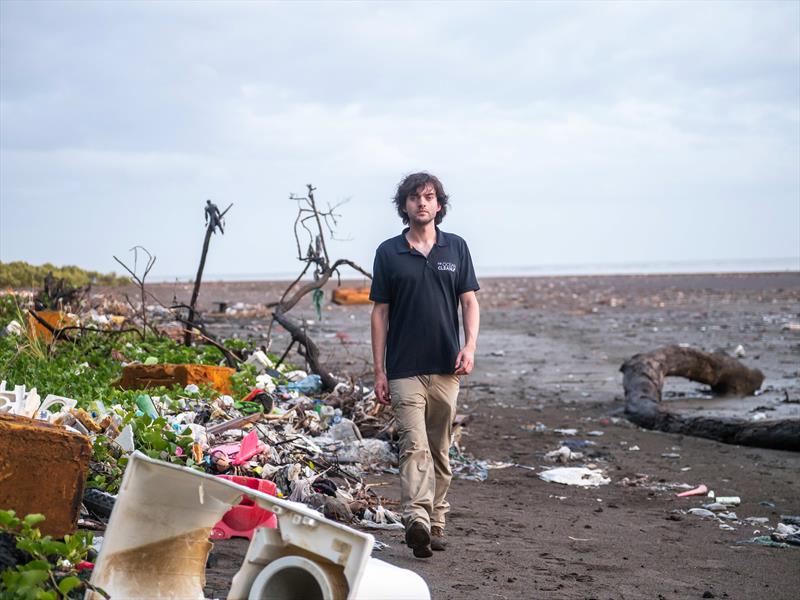
Celebrating Boyan Slat, The Ocean Cleanup, and the organization's 30 Cities Program
by David Schmidt 15 Jul 14:00 PDT
July 15, 2025

Boyan Slat, CEO of The Ocean Cleanup, in Panama © The Ocean Cleanup
The old cliche goes that one should avoid meeting one's heroes, as there's always a chance that the flesh-and-blood person might not live up to expectations. While I've never met Boyan Slat, the almost-31-year-old Dutch CEO of The Ocean Cleanup, the nonprofit that he founded in 2013 to remove floating plastic from the world's oceans by developing and scaling technologies, I'd gladly take this risk to thank him for the great work that he's been doing for the planet.
For anyone who doesn't know, The Ocean Cleanup's stated goal is to remove 90 percent of all floating plastic from the world's oceans by 2040. If successful, the organization will effectively put itself out of business, however this is a career risk that Boyan and his organization are willing to accept.
The organization's approach to sequestering and removing floating plastic has long involved oceans and rivers, and The Ocean Cleanup has created technologies for both environments.
Recently, however, the organization has also decided to target entire cities.
In all cases, The Ocean Cleanup has developed technologies and tactics for sequestering, collecting, and recycling this mess, and as mentioned, they have learned to scale these technologies (and tactics) to best fit the problem(s).
On the offshore side of the equation, The Ocean Cleanup has created System 03 (AKA "Josh"), which is a 1.19 nautical mile floating barrier (picture a massive U-shaped device) that consists of two wings that are each four meters deep. The inboard ends of each wing are attached to a centralized detention zone, which is effectively a giant garbage bag where the plastic refuse is collected, while the outboard ends are attached to two slow-moving vessels that each sail at about 2.5 knots.
Fish can swim in and out of System 03, and onboard cameras allow operators to see what's happening in real time.
Once the centralized detention zone is full (this can take a few days), one vessel takes both wings in tow, while the other retrieves the garbage bag and dumps its contents onto its deck, where it's sorted for recycling by the vessel's crew based on the types of plastic involved. The centralized detention zone is then reattached to the wings, and the skimming effort resumes operations.
The Ocean Cleanup sails System 03 through so-called hotspots (Example A: The Great Pacific Garbage Patch), which constantly move based on circulating ocean currents. Here, the organization uses computer modeling to try and determine the real-time locations of these hotspots, which they then skim clean with System 03.
Rivers, of course, present different challenges than floating garbage patches.
According to Slatt, just 1 percent of all rivers are responsible for carrying about 80 percent of all plastics into the world's oceans. In real-world terms, this represents 1,000 rivers, globally.
Here, a 1.19 nautical mile wide floating barrier isn't practical, so The Ocean Cleanup has created a portfolio of five different Interceptors designs, which can be deployed to rivers of different depths, widths, and flow rates to best match localized conditions.
In all cases, The Ocean Cleanup works with local partners to ensure that the plastic garbage that they are collecting is fed into the proper recycling streams.
Last month, The Ocean Cleanup unveiled their 30 Cities Program at the UN Ocean Conference (June 9-13), which was held in Nice, France. This program will scale and employ different Interceptors at 30 different cities in Asia and the Americas, with the stated goal of eliminating 30 percent of all plastic that's flowing towards the world's oceans by the decade's end.
Instead of focusing on individual rivers, the 30 Cities Program will instead concentrate on entire cities using a data-driven approach involving drones, GPS tagging, and AI-powered analysis. The initiative will focus on removing plastic detritus from rivers, coastlines, mangroves, and coral reefs, thus shutting off the flow of new plastics into the oceans, while also removing legacy plastics.
The Ocean Cleanup is targeting Panama City, Panama as their first deployment, and Mumbai, India; Manila, Philippines; Montego Bay, Jamaica; Jakarta, Indonesia; Kuala Lumpur, Malaysia; Bangkok, Thailand, and Los Angeles are set to follow.
"When we take on an entire city, instead of individual rivers, we can scale faster, reduce costs, and maximize impact," said Slat in an official communication. "Our analysis shows that strategically deploying Interceptors across just 30 carefully chosen cities can stop up to a third of river plastic pollution worldwide. This is the next big leap toward our ultimate goal of a 90 percent reduction in global ocean plastic pollution."
If you were lucky enough to have raced (or be racing) to Hawaii in this month's Transpac Race and noticed less plastic in the water than during your last marathon push to Diamond Head, odds are good that Slatt and The Ocean Cleanup were involved.
Given my job as a journalist, I've had the chance to meet many of my sailing, climbing, and mountaineering heroes. While there's always a risk of not liking the cut of someone's jib once they are standing in front of you, this is a risk I'd gladly take to meet Slatt.
Afterall, Slatt has dedicated his life to physically improving the health of the world's oceans. What's not to like about that jib?
To learn more about The Ocean Cleanup or to support their efforts, navigate your web browser to www.theoceancleanup.com
May the four winds blow you safely home.
David Schmidt
Sail-World.com North American Editor